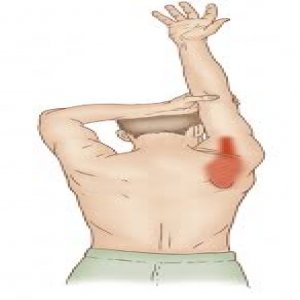Garbha Pindasana (Embryo in the Womb Pose)
What is Garbha Pindasana?
Garbha Pindasana, also known as the Embryo in the Womb Pose, is a seated yoga asana that involves a deep forward bend while holding the knees close to the chest. The name “Garbha Pindasana” is derived from the Sanskrit words “garbha,” meaning “womb” or “embryo,” and “pinda,” meaning “ball” or “round mass.” This asana is said to resemble a fetus in the womb, hence the name.
Garbha Pindasana is often practiced as part of the Ashtanga Yoga primary series and can be included in a yoga sequence that focuses on hip opening, spinal flexibility, and abdominal strengthening. It is usually performed towards the end of a practice session when the body is warm and more flexible.
To begin with, in padmasana, the knees are appropriated towards the body. Hands among the thighs and calf muscles sides, up to the back of the elbows. Elbows are bent and palms are obtained together, fingers suggesting up. To aggravate the pose, the hands can be seated on the ears.
The common English word for this posture is the embryo in the womb pose.
How to Do Garbhasana (Steps)
- Starting position, seat on your mat in padmasana, placing your left foot on your right thigh and your right foot on the left thigh.
- Thread your hands making a space among your thighs and calves up to elbows.
- Lift the legs near the shoulders along with turning your elbows and seat your hands on your facade with fingers below your ears.
- Here, you are seating completely on your buttocks.
- Press your heels on your stomach on each side of your umbilicus.
- Set your gaze to a point forward and bring five in-depth breaths.
- Then, slightly turn forward and try to duck your head into your hands.
- Next, as you exhale roll back on your spine to the right side
- Inhale, move up to the buttocks swiveling on the left of your spine.
- Maintain replicating the roll clockwise with the breath until you complete a circle.
- Inhale and sit up bringing your palms to the ground floor.
- Release the arms from the inserted position.
- Cross your legs on the opposite side while releasing your legs from padmasana, then repeat the previous steps.
- Straighten your legs and rest.
Garbha Pindasana Pose Video
Benefits Of Garbha Pindasana:
- Garbha Pindasana is a correct posture to release excess fat deposited in the stomach.
- The embryo in Womb Pose is a progressive yoga that requires flexibility in the hip, knees, and ankles.
- It is specifically beneficial for pregnant women and can be practiced in the 1st trimester.
- This yoga pose delivers activity to both the upper and lower body of the practitioner of this pose.
- It is considered that this posture supports preparing the embryo for the right position at birth.
- The practice of this pose provides complete spine ease, particularly the lower spinal muscles creating stress less.
- Regularizing the Garbha Pindasana strengthens the uterus and rectum.
- To accomplish this pose it is a belief that this pose supports a spiritual union between the brain and the soul.
- Everyday practice of this posture enhances the digestive system of the body and it even treats all kinds of stomach conditions.
- Toning of Abdominal Muscles: The posture engages the abdominal muscles as you hold the knees close to the chest and curl the body into a compact shape. Regular practice can strengthen and tone the abdominal muscles, providing improved core stability and a flatter stomach.
- Relaxation and Stress Relief: The asana requires concentration and deep breathing, which can induce a state of relaxation and calmness. It helps to reduce stress, anxiety, and mental tension, promoting a sense of well-being and tranquility.
- Energy Activation: Garbha Pindasana activates and stimulates the Manipura chakra, located in the navel area. This can help in balancing and harnessing the body’s energy, promoting a sense of vitality and inner strength.
Garbha Pindasana Modification (Womb Embryo Posture)
If you can not accomplish Lotus Posture with no issue, you can do a nice version of this problematic posture by simply leaning back and weaving your arms through a cross-legged position, and then proceeding to rotate back into a nice spinal flexion and turn back and forth tracing a circle.
Next, I provide you step-by-step instructions for bringing the arms through the legs that are folded into Lotus Posture. Be careful to proceed patiently without (forcing). By practicing day by day you will produce flexibility and win relief in the pose.
Variations
As experimenters have variable abilities, a provided yoga posture may be comfortable for a particular pupil but hard for another. In such cases, as a yoga teacher, you can instruct posture deviations to further challenge a pupil who is discovering a specific yoga pose comfortably or introduce an easier variation of an asana for the experimenter who is discovering the main pose hard.
Pose deviations can thus support your pupil’s development and create further confidence in their yoga practice no matter what their starting ability levels are. And this is where your role as a yoga teacher becomes very influential. Below we have compiled 40 pose deviations of Garbha Pindasana in one place to provide you with ideas to plan your yoga classes as you interact with learners of various levels.
Precautions & Contraindications
Do not conduct Garbha Pindasana if you are suffering from sciatica and other spinal issues.
If you have an injury in the ankles, knees, hips, and back, skip this asana.
Conduct Garbha Pindasana only if you can perform padmasana with comfort.
Conclusion
Garbha Pindasana, also known as the Embryo in the Womb Pose, is a seated yoga asana that involves a deep forward bend while holding the knees close to the chest. It resembles a fetus in the womb. The pose offers several benefits, including spinal health, digestive stimulation, hip opening, toning of abdominal muscles, energy activation, relaxation, and internal massage.
It is important to practice under the guidance of a qualified yoga teacher and be cautious if you have any pre-existing medical conditions or injuries. Modifications may be necessary, and it’s crucial to listen to your body’s limitations and not push beyond what feels safe and appropriate for you.
FAQ
1. What does Garbha Pindasana symbolize?
Definition – Garbha Pindasana is a developed yoga pose needing flexibility in the knees, hips, and ankles. It derives its name from the Sanskrit words Garbha, meaning “womb”, pinda, meaning “embryo”, and asana, meaning “pose” (“posture”).
2. What are the benefits of Garbha Pindasana?
Relaxes the full spine, and significantly the muscles of the lumbar spine. Useful for abdominal cramps and strengthens all abdominal muscles. Caution. This Asana shouldn’t be practiced with issues of the hips, knees, or ankles.
3. How many rolls are in Garbha Pindasana?
The practitioner moves the length of the spine 9th times, said to symbolize the nine months of gestation. It requires a very specific strength of the in-depth low abdomen and helps to massage and align the spine. Like all of the apex postures of the primary series, it is an in-depth spinal flexion.
4. What is the importance of Garbha?
Garbh Sanskar is one of the 16 sanskaras named for human beings. This is very essential. It is highly beneficial for physical development and for the evolution of the mind of the fetus. Garbh Sanskar is explained in more occasional words, Now, it educates the kid from the duration of the vision.
5. What is Garbhasana in yoga?
Embryo womb Pose Garbha means fetus or embryo, and asana means pose. It is a developed, established balancing posture that extends the hips and concentrates and stabilizes the brain. This intricate asana approximates a fetus in a mother’s womb.







